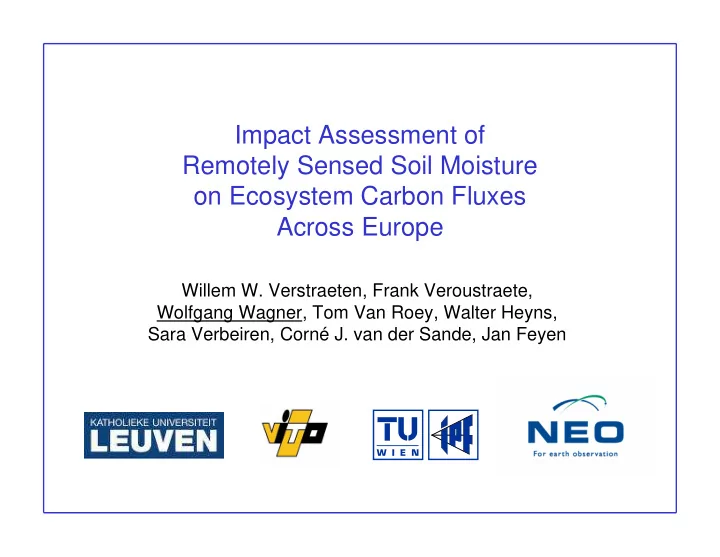

Impact Assessment of Remotely Sensed Soil Moisture on Ecosystem Carbon Fluxes Across Europe Willem W. Verstraeten, Frank Veroustraete, Wolfgang Wagner, Tom Van Roey, Walter Heyns, Sara Verbeiren, Corné J. van der Sande, Jan Feyen
Method • Use of the ERS scatterometer derived estimates of the relative profile soil moisture content as input into the production efficiency model C-Fix • C-Fix � Developed by VITO � fAPAR from satellite-NDVI Soil moisture • Applied over Europe content • Validated over EUROFLUX sites Gross primary Verstraeten et al. (2006) productivity Ecological Modelling Soil respiration
The Remote Sensing Perspective • Remote sensing can deliver spatially and temporally complete data � Land cover information � Geophysical parameters, e.g. biomass, soil moisture, … • Data could be used in different ways � Validation of model components � Initialisation, assimilation, … • Good Practice Guidance for Land Use, Land Use Change and Forestry (IPCC, 2003) � Different remote sensing techniques are discussed, but � No concrete advise of how to use them � No real incentives to use them • In practice, remote sensing is hardly used for GHG accounting
Reasons for Slow Adoption of Remote Sensing • Problems with � Satellite/sensor continuity � Relevant information? � Retrieval accuracy � Retrieval is often a mathematically ill-defined problem � High-level of abstraction needed for model formulation � Lack of suitable reference data � Retrieval errors generally not well known � "Interfaces" between GHG models and remote sensing data � Models parameterisation often not adapted to remote sensing data � Data assimilation rather complex
European C-Band Scatterometers • • 2 ERS scatterometers 3 METOP scatterometers (ASCAT) λ = 5.7 cm λ = 5.7 cm � � � � VV Polarization VV Polarization � � Resolution: 50 / (25) km Resolution: 50 / 25 km � � Daily coverage ~ 40% Daily coverage ~ 80% • • 1991-2008 2006 - 2020
Soil Moisture Retrieval • Change detection � Accounting for effects of vegetation phenology
Quality of Surface Soil Moisture I • Comparison with modelled surface soil moisture data � South-west France � RMSE error ~0.06 m 3 m -3 Pellarin et al. (2006) Geophysial Research Letters
Quality of Surface Soil Moisture II • Comparison with AMSR-E surface soil moisture product � R. de Jeu (Univ. Amsterdam) � M. Owe (NASA) � Year 2006
Quality of Surface Soil Moisture III • Internal error assessment through error propagation and Monte Carlo simulations
ASCAT Surface Soil Moisture Anomalies Date: 15-21 March 2007 Bartalis et al. (2007) Geophysical Research Letters
Soil Water Index (SWI) • SWI rests upon simple differential model for describing the exchange of soil moisture between surface layer ( Θ s ) and the “reservoir” ( Θ ) � T … characteristic time Θ ′ t − ⎡ ⎤ SWI is the discrete ( ) ( ) ( ) d 1 1 t t ∫ ′ ′ Θ = Θ − = Θ − Θ t t exp d t ⎢ ⎥ version of this integral s ⎣ ⎦ s T T dt T − ∞ Thin, remotely sensed soil layer with Θ s Root zone with Θ : layer of interest for most applications Soil profile
Global SWI Dynamics (1992-2000 Mean) Closed Forest Cover Azimuthal Effects Wet Soil Dry Soil Field Capacity Frozen Soil/Snow Cover Wilting Point
Russland & Ukraine Soil Moisture Network China • Gravimetric field measurements Illinois of soil moisture � 48 000 data points Indien Accuracy ≈ 5 % vol. � for 0-100 cm layer Location of in-situ soil moisture stations
SWI versus LPJ modelled Soil Moisture • Cooperation with PIK, Germany � Dieter Gerten and Wolfgang Lucht Correlation R Wagner et al. (2003) Journal of Geophysical Research
Results for Climate Classes Gerten et al. (2005) Geophysical Research Letters
SWI in C-Fix - Hyytiala, Finland EUROFLUX NEP C-Fix PWL NEP C-Fix FWL NEP 8.00 6.00 C-Fix model result with ERS derived SWI NEP [gC m -2 d -1 ] 4.00 2.00 0.00 Year: 1997 -2.00 -4.00 0 30 60 90 120 150 180 210 240 270 300 330 360 390 Julian Day [-]
SWI in C-Fix - Loobos, The Netherlands EUROFLUX NEP C-Fix PWL NEP C-Fix FWL NEP 15.00 12.00 C-Fix model result with ERS derived SWI -1 ] 9.00 -2 d NEP [gC m 6.00 3.00 Year: 1997 0.00 -3.00 0 30 60 90 120 150 180 210 240 270 300 330 360 390 Julian Day [-]
Difference in NEP with and without SWI SWI decreases NEP SWI increases NEP
Conclusions • The use of remotely sensed soil moisture data in C-Fix had a strong impact of modelled NEP � Some countries shift from being a sink to a source • Error structures are different in models and remote sensing data � A good agreement suggests a high quality of both methods � Poor agreement requires further analysis • Remote sensing of soil moisture: What is next? � Different AMSR-E soil moisture data have become available � ASCAT soil moisture will become operational in 2008 � SMOS will be launched in 2008
Nation- -Wide Airborne Laser Scanning Wide Airborne Laser Scanning Nation
Recommend
More recommend